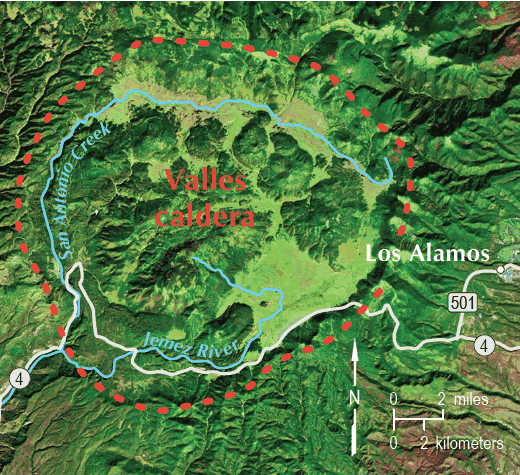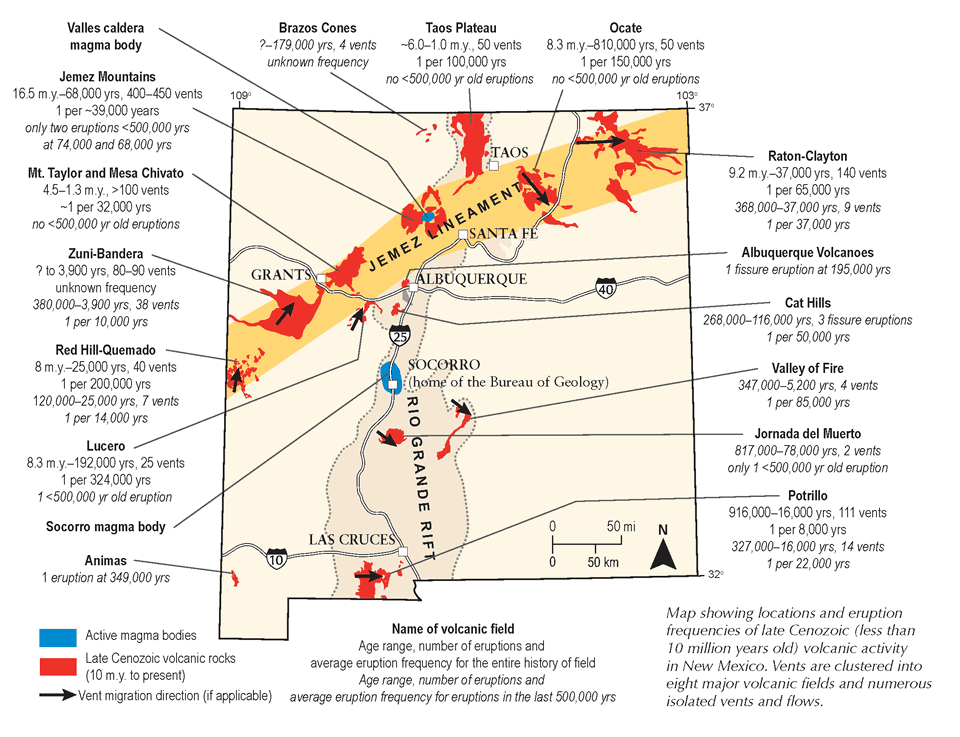
Volcanic Hazards in New Mexico
One of the greatest potential hazards in New Mexico, one not experienced by any humans in recent history, is a volcanic eruption from the many young volcanic fields found in the state.
New Mexico Volcanism
Recent volcanism in New Mexico can be divided into two broad periods of activity, each with their own distinctive traits. Between about 37 and 25 million years ago, a cluster of about twenty supervolcanoes (known as calderas to volcanologists, because of their resemblance to large caldrons) erupted in southwestern New Mexico, each of which injected dozens to hundreds of cubic miles of ash into the atmosphere, and spilled hot, incandescent ash-flows across the landscape. Before and after the colossal supereruptions, numerous “small” volcanoes erupted, producing explosions similar to the famous May 18, 1980 eruption of Mt. St. Helens. Thankfully, this field of New Mexico’s supervolcanoes is now extinct, and is beautifully exposed in the Gila Mountains and surrounding areas.

Beginning about 12 million years ago and continuing until about 3,900 years ago, the style of volcanic activity in New Mexico dramatically changed. Instead of the cataclysmic, caldera-forming eruptions, the younger volcanoes produced smaller eruptions of lava with very little ash. Some examples of these small volcanoes include cinder cones (steep-sided cones built from the accumulation of small, cooled fragments of lava called cinders), shield volcanoes (volcanoes with very shallow slopes formed by many lava flows), fissure vents (lines of small volcanoes that erupt along a fracture), and maar craters (formed when rising magma meets groundwater, causing a violent steam explosion). This younger pulse of activity is clustered into eight major volcanic fields and a few isolated vents and related flows. Some of these volcanic fields are located in the Rio Grande rift. Others are located along a feature called the Jemez lineament, a zone of crustal weakness that has focused volcanic activity along a northeast-trending line. Although most eruptions in New Mexico in the last 10 million years are small, the Valles caldera, also known as “New Mexico’s supervolcano,” produced two immense, explosive eruptions at 1.6 and 1.2 million years ago, generating widespread ash falls.

Future Volcanic Activity in New Mexico

Although there hasn’t been an eruption in New Mexico in almost 4,000 years, there are three lines of evidence that suggest future volcanic activity is likely.
- Two places in New Mexico are underlain by relatively shallow magma that could erupt. The Socorro magma body exists at a depth of about 12 miles. The other is located beneath the Valles caldera at depths of 3 to 9 miles.
- Thousands of volcanoes have erupted during the last 10 million years, including 700+ in the last 5 million years, and 350 in the last 2 million years.
- There have been at least four eruptions in the last 11,000 years, suggesting the long episode of activity that began 10 million years ago is not over.
These aspects of New Mexico volcanism suggest that future activity is not a question of if, but when!
Although there is no indication that New Mexico will experience an eruption any time in the near future, volcanic activity in our state is certainly not over. Periods of inactivity of several thousands of years, such as the one we are in now, are common, having happened many times in recent geologic history. Nevertheless, volcanic eruptions pose a real and perhaps underappreciated threat to New Mexicans. Hence, geologists remain vigilant to quickly identify any signs of a volcanic awakening, such as increased seismicity due to moving magma, changes to gas emissions, changes to hot and cold springs, changes to geothermal features above magma chambers, and ground uplift that might indicate magma moving closer to the surface. Additional studies to understand past eruptions are underway and will help us prepare for an eruption scenario in the future, when volcanic activity returns to The Land of Enchantment.

